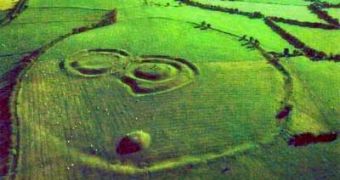Great archaeological discoveries come when not expected. The construction of a controversial four-lane highway in Ireland dug up the site of an open-air royal temple dating from the Stone Age.
The large circular enclosure is over 2,000 years old and it can be seen now at Lismullin, in County Meath. The discovery is located at only 1.25 miles (2 kilometers) from the famous Celtic Hill of Tara, the seat of Irish kings and could have been a ritual site. The new 37 mile (60 km) long road at the northwest of Dublin had to ease congestion along a busy commuter route to the Irish capital.
Fierce opposition from those intending to save the ancient remains halted the work in April, after archaeologists with the National Roads Authority (NRA) reported a large timber monument 80 m (262 ft) wide, with a 16-m (52 ft)-round structure inside.
Inside the site a stone ax head, a pottery fragment and an ornamental pin were discovered and nearby an ancient dog remains were found.
Archaeologists believe the monument belonged to a religious complex around the Stone Age Hill of Tara, Ireland's equivalent of Stonehenge or Egypt's Pyramids.
"It's commonly recognized that this valley [where the new site was found] is part of Tara, which is the pre-eminent archaeological site of our nation," said archaeologist Joe Fenwick of the National University of Ireland, Galway.
The setting and the small number of findings points to a rather ritual role of the site.
"Its low-lying position means you have no view once you're inside the monument, so you wouldn't have seen anyone approaching. This would be unusual for a prehistoric settlement. They are usually found on hilltops." said Mary Deevy, NRA chief archaeologist.
"The thing that gives it away is this funnel-shaped approach from the east between the outer and inner enclosures. This is a recurring feature at all the major royal sites where you have a circular temple. Ceremonies and worship performed at these monuments may have been related to cosmology and royal inauguration," said Fenwick.
The site is believed to have been operational between 1000 and 0 B.C.
"The chosen motorway route, unfortunately, goes right through the heart of this landscape," explains Fenwick.
The Lismullin site is a national monument, but 2004 Irish Legislation allows for national monuments to be "destroyed" if the environment minister finds this is "in the public interest."
"A lot of people think that this is what's going to happen," Fenwick said.
The National Museum of Ireland in Dublin is going to make a complete archaeological research of the site while many are questioning why it wasn't detected earlier.
"It's not enough to reroute just around this particular site. People would argue that the motorway should be rerouted out of [what was] the royal domain of Tara altogether." added Fenwick.

 14 DAY TRIAL //
14 DAY TRIAL //